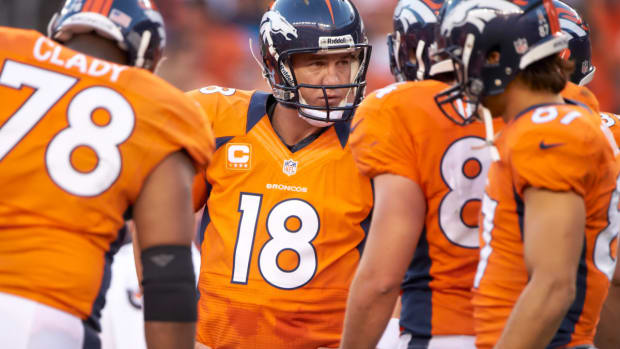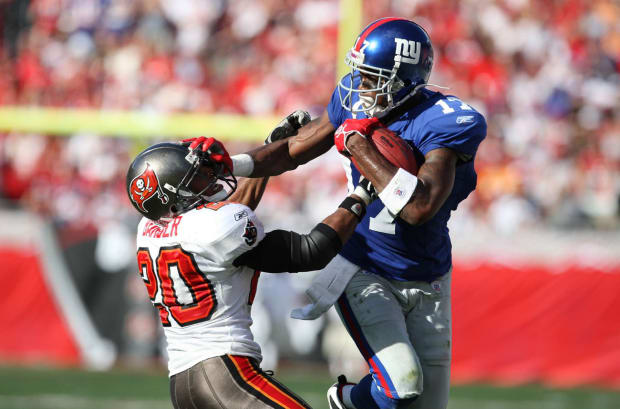SI Fantasy analyst Michael Fabiano recaps the best free agent signings that led to huge fantasy value in the coming years
The 2021 free-agent period is slated to be one of the most exciting maybe ever. With many big names likely to change teams, we are certain to have plenty to analyze and discuss in the coming weeks. Until then, let’s take a trip down memory lane and look at some of the best free-agent signings based on fantasy value over the last 30 years.
The parameters are simple. Each player had to move from one NFL team to another, which is the reason you won’t see Warren Moon (CFL to NFL) or any undrafted free agents like James Robinson. The player also had to see a rise in fantasy value, at least on some level. For example, Jerry Rice moving to the Oakland Raiders in 2001 was a good free-agent move, but he had been great in San Francisco, so he wouldn't fit.
So without further ado, here’s my top 12 best free-agent player moves since 1990.
1. Drew Brees (2006)
Brees played five seasons in San Diego at the start of his career, before signing with the Saints in 2006. That was one of the best moves in the history of fantasy football, as Brees went on to produce huge totals while running coach Sean Payton’s offense. He threw for more than 4,500 yards eight times, including four 5,000-yard campaigns, and produced a bananas 491 touchdown passes in 228 games.
MORE FANTASY ARTICLES FROM MICHAEL FABIANO2. Priest Holmes (2001)
Holmes was mostly an afterthought in fantasy circles in his first four seasons in the NFL, as he rushed for more than 588 yards just once in that time with the Ravens. He moved on to Kansas City in 2001, however, and his stock soared under coach Dick Vermeil. Over the next three years, Holmes led all running backs in rushing yards, receiving yards, total touchdowns, and overall fantasy points.
3. Michael Turner (2008)
Turner was stuck behind LaDainian Tomlinson for his first four seasons in San Diego, which severely limited his fantasy appeal. He went on to sign with the Falcons and thrived in the stat sheets right out of the gate, rushing for almost 1,700 yards and 17 touchdowns while finishing fourth in fantasy points among backs. He went on to rush for a combined 60 touchdowns in five seasons in Atlanta.
4. Peyton Manning (2012)

Manning was a superstar in Indianapolis, but he saw his stock decline when a neck injury caused him to miss the entire 2011 season. The Colts drafted Andrew Luck, allowing Manning to move on to Denver as a free agent. His stock went back on the rise with the Broncos, as he recorded 14,863 passing yards and 131 touchdown passes in his next 48 games and was a top-six quarterbacks three times.
5. Rich Gannon (1999)
Gannon had a mostly forgettable NFL career during his time in Minnesota, Washington, and Kansas City, but moving on to Oakland was a godsend. In his first four seasons with the Raiders, he averaged nearly 4,000 passing yards, 303 rushing yards, and 29 total touchdowns. He finished no worse than third in points during that time, including one season (2002) where he was the top fantasy quarterback.
6. Kurt Warner (2005)
Warner was a superstar during his time in St. Louis, but injuries became an issue in 2002, and he ultimately signed with the Giants for one forgettable season (2004). He went on to sign with the Cardinals the following year to back up Matt Leinart, but he took over the top spot and re-established himself as a fantasy asset. Warner also led the Cardinals to its only franchise appearance in a Super Bowl (XLIII).
7. Keenan McCardell (1996)
McCardell was drafted by the Redskins but started his playing career in Cleveland, where he had just one season with more than 234 yards. He went on to sign with Jacksonville, where he became a valuable fantasy asset. Over the next six seasons, McCardell put up 70+ catches five times, 1,000+ receiving yards four times, and formed a solid fantasy wideout combination with Jimmy Smith.
8. Jay Novacek (1990)
Novacek had one good season with the Cardinals before signing with the Cowboys as a Plan B free agent. He went on to post 600+ yards in each of his next four seasons, during which time he finished as a top-three tight end three times, including one year when he ranked first (1992). Novacek also produced a career-best 705 yards and finished third in points in his final season in Dallas (1995).
9. Ed McCaffrey (1995)
McCaffrey opened his career with four mediocre seasons in New York and San Francisco, during which time he produced one year with more than 600 yards. He went on to record three seasons with 1,000+ yards and five seasons with at least seven touchdowns. He combined with Rod Smith to form a potent fantasy duo that even finished in the top five in points at the position during the 2000 campaign.
10. Plaxico Burress (2005)

Burress had two good seasons in Pittsburgh before seeing his totals fall in 2003 and 2004. He went on to sign a deal with the Giants the following year and shined, posting a combined 207 catches, 3,227 yards, and 29 touchdowns over his final three seasons. Burress played in 10 games in 2008 and missed the next two seasons due to off-the-field issues, but his move to New York increased his value.
11. Curtis Martin (1998)
Martin was very productive during his three seasons with the Patriots, during which time he scored 37 total touchdowns. He signed with the Jets in 1998 and was even better, rushing for 1,000+ for seven straight seasons while scoring a combined 63 total touchdowns. That includes a 2004 campaign when Martin rushed for a league-high 1,697 yards and 12 touchdowns in his age-32 season.
12. Shannon Sharpe (1999)
Sharpe was an absolute fantasy monster during his time with the Broncos, but he missed all but five games during his final year with the team. He signed with the Ravens the following season at age 32 and re-emerged into a star, ranking in the top three in points among tight ends in Baltimore's two seasons. Sharpe retired as one of the greatest tight ends in NFL history.
Michael Fabiano is an award-winning fantasy football analyst on Sports Illustrated and a member of the Fantasy Sports Writers Association (FSWA) Hall of Fame. You can follow Michael on Twitter, Facebook, YouTube, and Instagram for all of the latest breaking fantasy football news and the best analysis in the business!



0 Comments